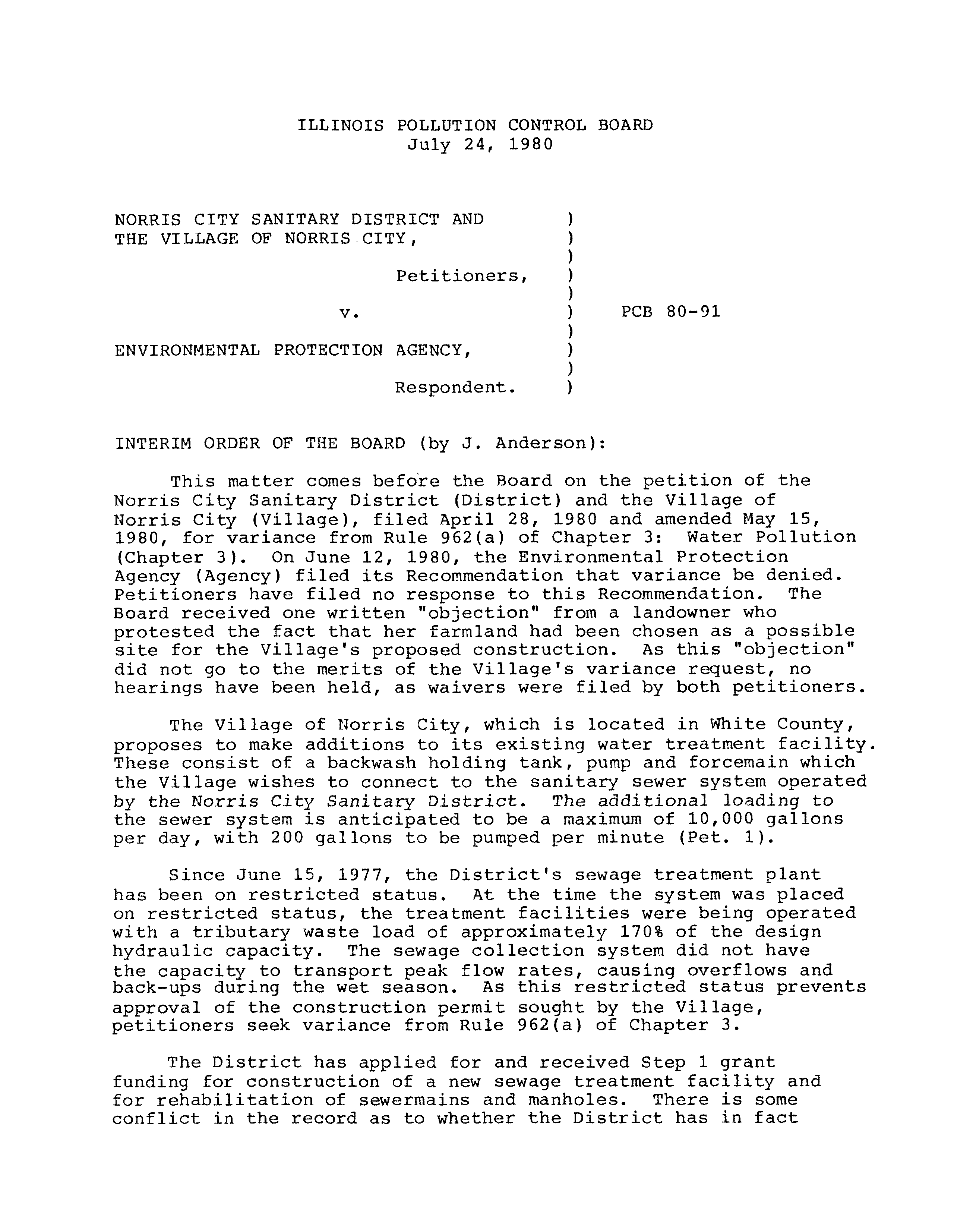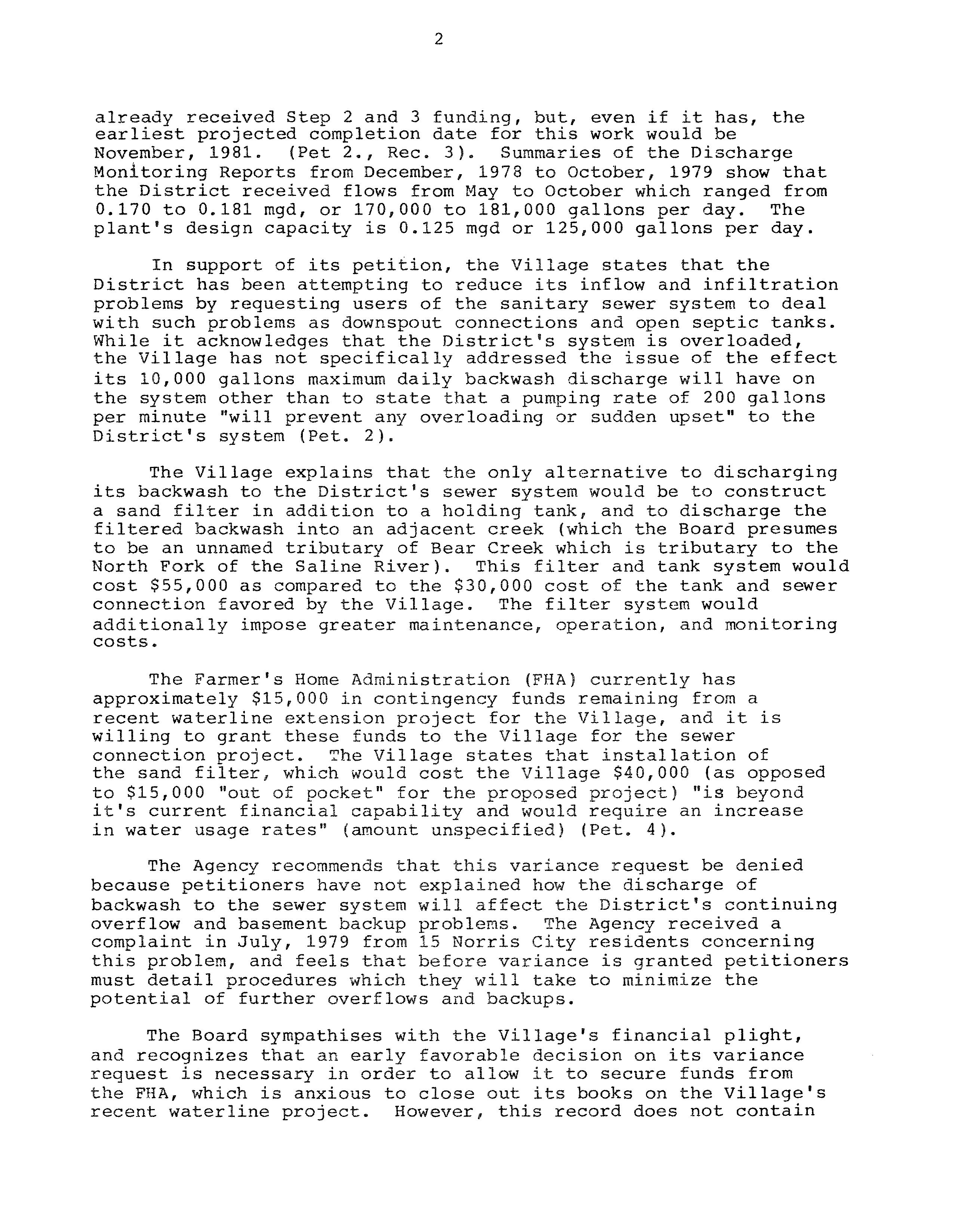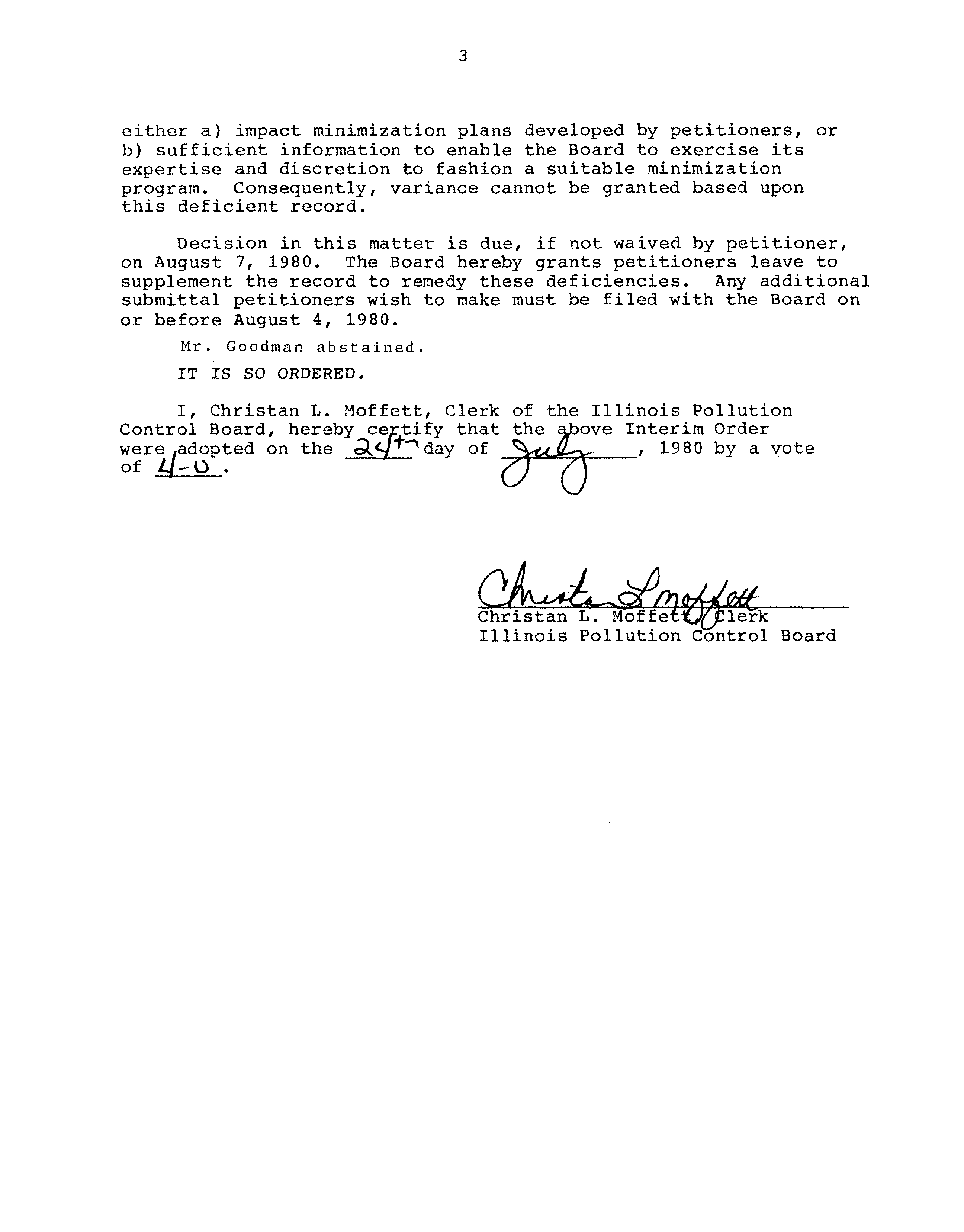ILLINOIS POLLUTION CONTROL
BOARD
July 24,
1980
NORRIS CITY SANITARY DISTRICT AND
THE VILLAGE
OF NORRIS.CITY,
)
Petitioners,
v.
)
PCB
80—91
ENVIRONMENTAL PROTECTION AGENCY,
)
)
Respondent.
INTERIM ORDER OF THE BOARD
(by J.
Anderson):
This matter comes before the Board on the petition of the
Norris City Sanitary District
(District)
and the Village of
Norris City
(Village),
filed April 28,
1980 and amended May
15,
1980,
for variance from Rule 962(a)
of Chapter
3:
Water Pollution
(Chapter 3).
On June 12,
1980, the Environmental Protection
Agency
(Agency)
filed its Recommendation that variance be denied.
Petitioners have filed no response to this Recommendation.
The
Board received one written “objection” from a landowner who
protested the fact that her farmland had been chosen as a possible
site for the Village’s proposed construction.
As this “objection”
did not go to the merits
of the Village’s variance request,
no
hearings have been held,
as waivers were filed by both petitioners.
The Village of Norris City, which is
located in
White
County,
proposes to make additions to its existing water treatment facility.
These consist of
a backwash holding tank, pump and forcemain which
the Village wishes to connect to the sanitary sewer system operated
by the Norris City
Sanitary
District.
The additional
loading to
the sewer system is anticipated to be a maximum of 10,000 gallons
per day, with 200 gallons to be pumped per minute
(Pet.
1).
Since June
15,
1977,
the District’s sewage treatment plant
has been on restricted
status.
At the time the system was placed
on restricted
status,
the treatment facilities were being operated
with a tributary waste
load of approximately 170
of the design
hydraulic capacity.
The sewage collection system did not have
the capacity to transport peak flow rates,
causing overflows and
back—ups during the wet season.
As this restricted status prevents
approval of the construction permit sought by the Village,
petitioners seek variance from Rule
962(a) of Chapter
3.
The District has applied for and received Step
1 grant
funding for construction of
a new sewage treatment facility and
for rehabilitation of sewermains and manholes.
There
is some
conflict in the record as to whether the District has
in fact
2
already received
Step
2 and 3 funding, but, even if it has, the
earliest projected completion date for this work would be
November,
1981.
(Pet 2., Rec.
3).
Summaries of the Discharge
Monitoring Reports from December,
1978 to October, 1979 show that
the District received flows from May to October which ranged from
0.170 to 0.181 mgd, or 170,000 to 181,000 gallons per day.
The
plant’s design capacity is 0.125 mgd or 125,000 gallons
per
day.
In support of its petition, the Village states
that
the
District has been attempting to reduce its inflow
and
infiltration
problems by requesting users of the sanitary sewer system to deal
with
such
problems
as
downspout
connections
and
open
septic
tanks.
While
it
acknowledges
that
the
District’s
system
is
overloaded,
the
Village
has
not
specifically
addressed
the
issue
of
the
effect
its 10,000 gallons
maximum
daily backwash discharge will have on
the
system
other than to state that a pumping rate of 200 gallons
per minute “will prevent
any
overloading
or
sudden
upset”
to
the
District’s
system
(Pet.
2).
The Village explains that the only alternative to discharging
its
backwash
to
the
District’s
sewer
system
would
be
to
construct
a
sand
filter
in
addition
to
a
holding
tank,
and to
discharge
the
filtered
backwash
into
an
adjacent
creek
(which
the
Board
presumes
to
be
an
unnamed
tributary
of
Bear
Creek
which
is
tributary
to
the
North
Fork
of
the
Saline
River).
This
filter
and
tank
system
would
cost $55,000 as compared to the $30,000 cost of the
tank
and sewer
connection favored by the Village.
The filter system would
additionally impose greater maintenance, operation, and monitoring
costs.
The
Farmer’s
Home
Administration
(FHA)
currently
has
approximately $15,000 in contingency
funds
remaining from a
recent waterline extension project for the Village, and it is
willing to grant these funds to the Village for the sewer
connection project.
The
Village states that installation of
the sand filter, which would cost the Village $40,000
(as
opposed
to $15,000 “out of
pocket”
for the proposed project) “is beyond
it’s current financial capability and would require an increase
in water usage rates” (amount unspecified)
(Pet.
4).
The Agency recommends that this variance request be denied
because petitioners have not explained how the discharge of
backwash to the sewer system will affect the District’s continuing
overflow
and
basement
backup
problems.
The
Agency
received a
complaint
in July,
1979 from 15 Norris City residents concerning
this problem, and feels that before variance is granted petitioners
must detail procedures which they will take to minimize the
potential of further overflows and backups.
The Board sympathises with the Village’s financial plight,
and recognizes that an early favorable decision on its variance
request is necessary in order to allow it to secure
funds
from
the FHA, which is anxious to close out its
books
on the Village’s
recent waterline project.
However,
this record
does
not contain
3
either a) impact minimization plans developed by petitioners,
or
b) sufficient information
to enable the Board to exercise its
expertise and discretion to fashion a suitable minimization
program.
Consequently, variance cannot be granted based upon
this deficient record.
Decision in this matter is due,
if not waived by petitioner,
on August
7,
1980.
The Board hereby grants petitioners leave to
supplement the record to remedy these deficiencies.
Any additional
submittal petitioners wish to make must be filed with the Board on
or before August
4,
1980.
Mr.
Goodman
abstained.
IT
IS SO ORDERED.
I, Christan L. Moffett,
Clerk
of the Illinois Pollution
Control Board, hereby ce tify that the
ove Interim Order
wer,~adoPtedon the
~(J~’day
of
___________,
1980
by a vote
Christan L. Moffe t.4’Jlerk
Illinois Pollution Control Board



